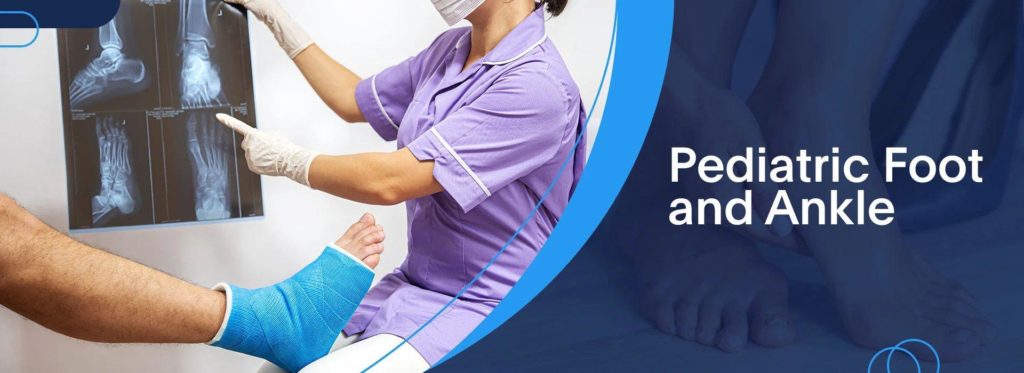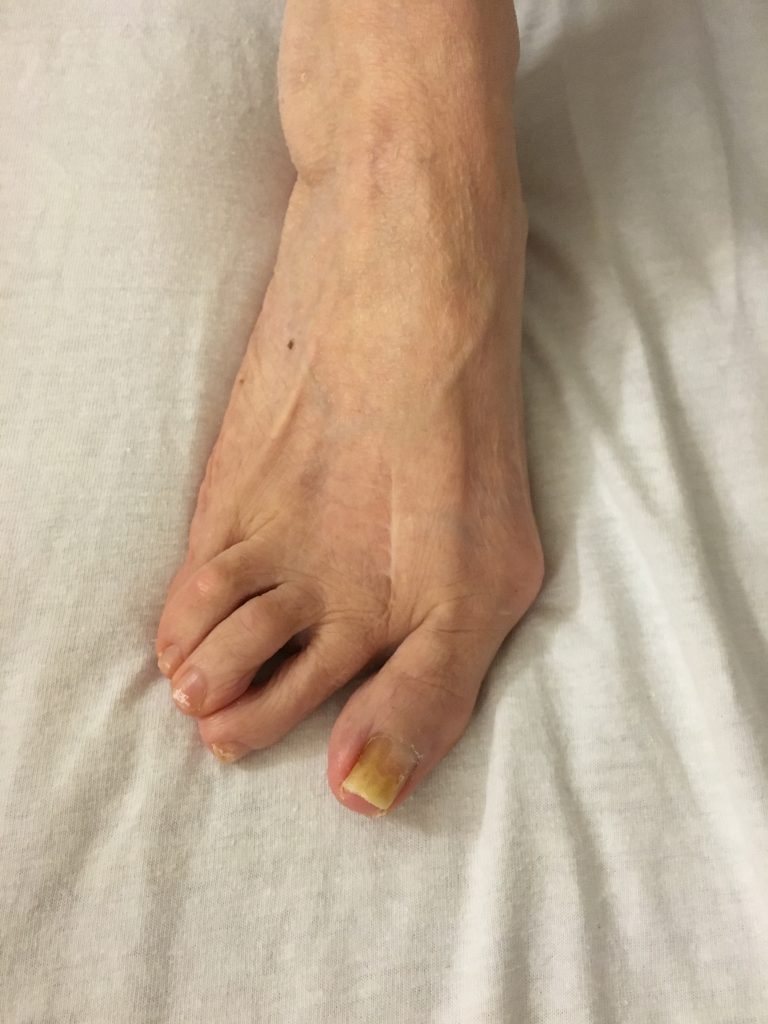Bunions are a common foot condition that can cause pain and discomfort. In this article, we will cover bunions, including their definition or deformation, broad variations, and different effects on people’s lives.
Bunions can occur in people of any age, but they are more common among adults, particularly women. The substantial lifestyle impact that this kind of will bring to an individual is obvious enough in daily life. It makes walking difficult, working out is painful, standing insufferable, and simply making a living quite uncomfortable.
If bunion symptoms can be recognized and treatment started promptly, it may halt their further development as well as alleviate associated pain. And finding out what treatment options you have can help you make better decisions concerning foot health on your behalf.
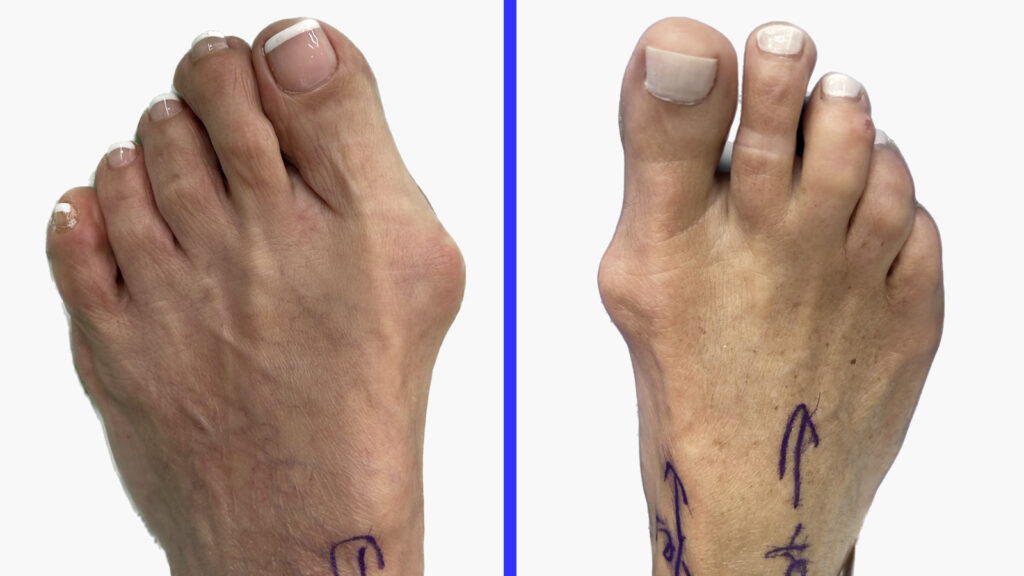
What is a Bunion?
A bunion is a common foot deformity, medically referred to as hallux abducto valgus. Often you’ll see a bony enlargement at the base of the big toe, which is caused because the first metatarsal has deviated from its original position due to pronatory forces. The big toe starts to deviate towards the second toe causing malalignment of the first MPJ and a visible bump on the inside of your foot.
A bunion occurs in the first MTP joint, which is where the first metatarsal bone of a foot meets with the proximal phalanx bone of one’s big toe. This joint transfers 85% your weight when walking and doing other activities. When the MTP joint becomes misaligned, a bunion will result. Bunions are not always painful.
Eventually, these misalignments force the metatarsal bone to drift away from its normal position while, at the same time, the big toe moves inward. This misplacement creates the characteristic swelling and deformity of the toes associated with bunions.
Bunion Types
Bunions can come in all different shapes and sizes; they may appear on one foot or both feet. The most common type of bunion occurs at the base of the big toe (first metatarsophalangeal joint), but it can also be found at the base of the fifth toe (tailor’s bunion). The latter is known in medicine as a bunionette and typically grows laterally from the foot near one’s little toe; it may form through any contact that constantly rubs against tight shoes.
Signs and Symptoms of Bunions
Regardless of its location on the foot, a bunion can be painful or cause discomfort. Learning how bunions develop is the first step in effectively managing this common foot problem so as to improve people’s quality of life.
The characteristic pain, which can be local or spread to the atrial-large joint and its perimeter, is usually unbearable. The pain in the bunion often flares up suddenly or becomes unbearable, depending on footwear, activity level, and the development stage of the bunion.
Patients with bunions might experience pain in the underside of the large toe or along one side of the foot and discomfort when walking, standing, or bearing weight on the affected foot. They also have this feeling of walking on air or balls. There may also be swelling and inflammation in the area of the bunion.
The bunion pain may increase as time passes, and the deformity becomes more severe. In some cases, this pain is even felt throughout the foot or contributes to some side issues, such as corns, calluses, or bursitis.
Physical Appearance Changes
Bunions can cause significant changes to the appearance of a foot. Most noticeable is the point where the bone projects out from inside your foot or anywhere near this region. Physical signs of bunions include:
- There is a visible bump on the side of the foot at the base of the large toe
- Redness, soreness, or swelling around the bunion
- Deflection of the big toe back towards the second toe and overlapping toes
- Changes in the line (alignment) of the toes, like crowding or spaces between them
Such physical changes can, of course, affect the way a shoe feels and may cause difficulties fitting one right over the top of these protrusions. Over time, the bunion will increasingly stand out, making it more difficult to disguise or ignore.
Impact on Mobility and Daily Activities
Bunions can markedly interfere with an individual’s general mobility and ability to engage in daily activities. The deformity can change the way the foot works mechanically, upsetting both balance and gait. Consequently, people with bunions may find themselves experiencing:
- Difficulty walking properly or keeping their feet in the desired alignment
- Handicapping of the affected toe joint during movement or rest periods
- Discomfort or fatigue after standing up for a long time or walking long distances
- Unable to participate in sporting activities or wear particular types of shoes
Functional limitations due to bunions can severely affect the quality of life. Work, leisure, and social activities are all likely to be impeded because of this condition’s progress.
Bunion Causes and Risk Factors
In order to prevent and treat this disease effectively, we need to identify the real factors causing it. One thing is certain, although no one knows exactly the cause or reasons for big toe bunions. In fact, a number of common factors are important in their development. Thus, we should list detailed information as follows: The major causes and risk factors for bunions are:
Genetic Predisposition
Genetics plays a key role in causing bunions to develop, with hereditary factors responsible for this foot deformity. Research suggests that bunions are often hereditary and that genetic predisposition is inherited in families. Certain foot structures and biomechanical abnormalities can also be transmitted from parents to children.
With a history of bunions in people’s families, others in the same family are likely to get the disorder, which illustrates the foremost significance of inheritability. Though we cannot modify genetic factors, recognition of the inherited predisposition can prompt active measures in other areas to reduce modifiable risk factors, thereby constraining the progress and impact of bunions.
Foot Structure and Mechanics
An individual’s foot structure and the way in which their feet work can greatly influence how likely they are to acquire bunions. Certain foot characteristics and conditions can lead directly to abnormal pressure distribution or joint misalignment, causing people to develop bunions. Foot factors that often contribute to bunions include:
- Flat feet or high arches
- Overpronation or an excessive roll of the foot when walking
- Abnormal alignment of the bones, joints, muscles, or ligaments within the foot system
- Laxity of ligaments of the foot and ankle complex
These structural variations change the way force is applied to different parts of the foot and can produce bunion toe deformities over time. Correction of foot mechanical deformities might help reduce the incidence of bunions and their accompanying symptoms through the use of orthosis or physical therapy.
Footwear Choices
Wearing certain kinds of shoes on a regular basis may have a certain effect on the advancement and worsening of bunions. Tight, narrow, or poorly fitting shoes put undue pressure on the toe and forefoot, leading to both friction and irritation. The combination of such stresses often results in the displacement of joints. High-heeled shoes and boots are particularly to blame because they tend not only to push the body’s weight forward but also squeeze the toes into an extremely small space.
Other Contributing Factors
Many other factors can exacerbate or lead to the formation of bunions, in addition to genetic predisposition and foot structure. These include:
- Heel-toe changes in foot structure and function due to age
- Sex, for the female sex, suffers from bunions somewhat more than males (though why this is so we still don’t know exactly)
- Various systemic ailments: rheumatoid arthritis and other connective tissue diseases
- Occupational situations that cause an excessive amount of standing, walking, or otherwise strain on the feet
By addressing these contributing influences in the way one lives, the shoes he wears, and conscientious foot care, the likelihood of bunions and poor foot health generally can be minimized. Through better knowledge about what leads to bunions or creates risk factors for this common condition of the feet, people can then more effectively stop it.
Diagnosis of Bunions
Bunion diagnosis involves examining the feet and taking a series of diagnostic tests, which requires consultation with a qualified medical professional. Prompt diagnosis is essential for developing a treatment plan that will take care of the symptoms associated with bunions as well as cure the disease itself. The following main methods diagnose bunions:
Clinical Examination
Diagnosis of bunion usually starts with a comprehensive clinical examination by a professional healthcare provider (such as a podiatrist or orthopedic surgeon). During this examination, the healthcare provider will appraise various aspects of foot anatomy, alignment, and function, including:
- Visual inspection: In this part, the health care provider will visually check the affected foot for any signs of bunion, such as a visible bump at the base of the big toe or changes in toe alignment.
- Palpation: The health care provider might lightly rub their hand around your bunion area to see if it hurts, is tender, or if you’re merely feeling bony prominence.
- Range of motion: The range of motion with which the affected toe joint swings can be examined to identify any restrictions or abnormalities.
- Gait analysis: By watching the patient’s walk (gait pattern), information about how bunion foot mechanics and overall function are disrupted and operate can be gained.
Basing a preliminary diagnosis on the findings from the clinical examination, the healthcare provider will recommend further diagnostic tests if necessary.
Imaging Tests
Imaging tests are frequently used to confirm a diagnosis of bunions and assess the level of deformity. The following imaging techniques may be used:
- X-rays: X-ray imaging is the most common diagnostic tool for assessing bunions. X-rays present both close-up images showing bones and joints in the foot and greater context images showing the degree and character of joint misalignment, factors like bony prominence, and other structural abnormalities associated with bunions. X-rays must be performed weightbearing in order to fully evaluate the correct angles.
- Other Imaging Modalities: In some cases, additional imaging tests such as magnetic resonance imaging (MRI) or computed tomography (CT) scans may be ordered to get more detailed information on the bunion deformity.
Imaging exams serve the double purpose of letting health professionals see the extent of height displacement that will guide their further diagnostic reasoning when tailored treatments are recommended to suit varying individual needs and preferences.
Bunion Treatment Options
If you address your bunion, it will usually involve a combined treatment of conservative steps and, in some cases, surgical intervention. The treatment goal is to reduce symptoms, hold further deformity progression, and help you both address this postural syndrome together. Below are the primary treatment options for bunions:
Conservative Approaches
Conservative treatments are usually the first management approach for mild to severe bunions. These non-invasive interventions aim at providing relief from symptoms, reducing pressure on the affected region, and promoting the proper alignment of a person’s feet. Such conservative or nonsurgical treatments might encompass the following:
- Shoe Adjustment: Wearing shoes that fit properly and have a wide toe box is a common method of reducing bunion pressure and easing your discomfort. Recommendations for people with mild to severe bunions include staying away from high heels, narrow or pointed shoes, and rigid or tight toe boxes. Also, wear comfortable shoes with adequate arch support and padding. You can improve foot mechanics plus lessen the strain placed on your specific area affected.
- Orthotic Devices: Custom molded orthotic devices, such as shoe inserts or arch supports, can add a little extra cushioning and leverage to the foot. Devices like orthotics help to distribute, more evenly, the pressure below the arch, which also tends to power trophic biomechanical imbalances and precipitate problems like bunions. Use the orthotic inside shoes for constant support and relief throughout the day.
- Physical Therapy: As prescribed by a physical therapist, specific exercises and stretches can help strengthen both the muscle and ligament groups around the feet and ankles. You can increase your flexibility and enhance overall foot function by physiotherapy, which also includes gait and postural mechanics. The hands-on analysis can relieve pressure from any bunion–at which point discomfort will be reduced to some extent.
- Pain Management: With bunions causing pain and inflammation in the foot, over-the-counter pain relieving tablets such as acetaminophen or nonsteroidal anti-inflammatory drugs (NSAIDs) may be used. Topical pain relievers or ice packs could help to calm the pain for a while.
Moreover, it is important to consult a health care provider because there are so many different ways to manage bunions, and what will work in one case may not necessarily be appropriate for another.
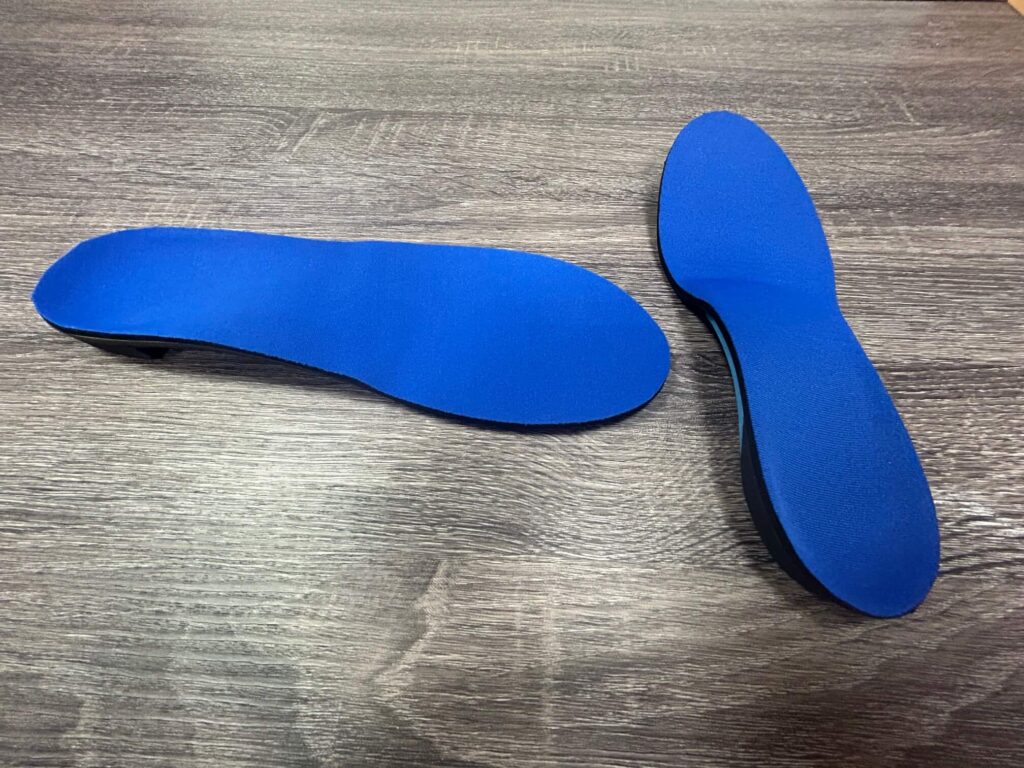
Bunion Surgery
If conservative treatments fail to provide relief or the bunion deformity seriously impairs one’s mobility and quality of life, surgical intervention may be considered. Bunion surgery aims to realign the joint that has been affected, remove any lumps of bone, and correct any structural abnormalities within the foot or toe.
Bunion surgery includes several methods intended to deal with different aspects of bunion deformity and underlying foot structure. Common bunion surgery types are:
- Osteotomy. This involves cutting and realigning the bones around the big toe joint to put the right big toe misalignment. Osteotomies can be done at the base of the metatarsal bone (proximal osteotomy) or at the head of the metatarsal (distal osteotomy).
- Exostectomy. Here, the surgeon removes part or all of the bony bump (exostosis) on the side of the foot without realigning the joint. The limitations of this procedure are that it’s only really useful for mild bunions and doesn’t involve correction. Think about how much easier an experience it would be to shorten lines across your toes, for example.
- Arthrodesis. Following arthrodesis, the bones of the big toe joint are fused to give stable back-end support and keep further disfigurement from occurring. This operation may be suitable for severe bunions or cases in which joint arthritis exists.
- Arthroplasty. Arthroplasty is removing damaged or arthritic joint surfaces and replacing them with artificial implants or grafts. This procedure may be needed for complicated bunions that have substantial joint damage.
- Lapiplasty . Helps to 3d realign the metatarsal at the root of the deformity for moderate to severe deformities. Lapiplasty procedure is an arthrodesis of the metatarsal cuneiform joint.
- MIS Bunionectomy. Bunion can now be performed through small incisions than ever for faster recovery and less pain.
The choice of procedure will depend upon such factors as the severity of the bunion deformity, any underlying foot pathology present, and the individual patient’s treatment needs and wishes. At the Foot, Ankle, & Leg Vein Center, we perform all types of bunion and will decide which is the best choice for you.
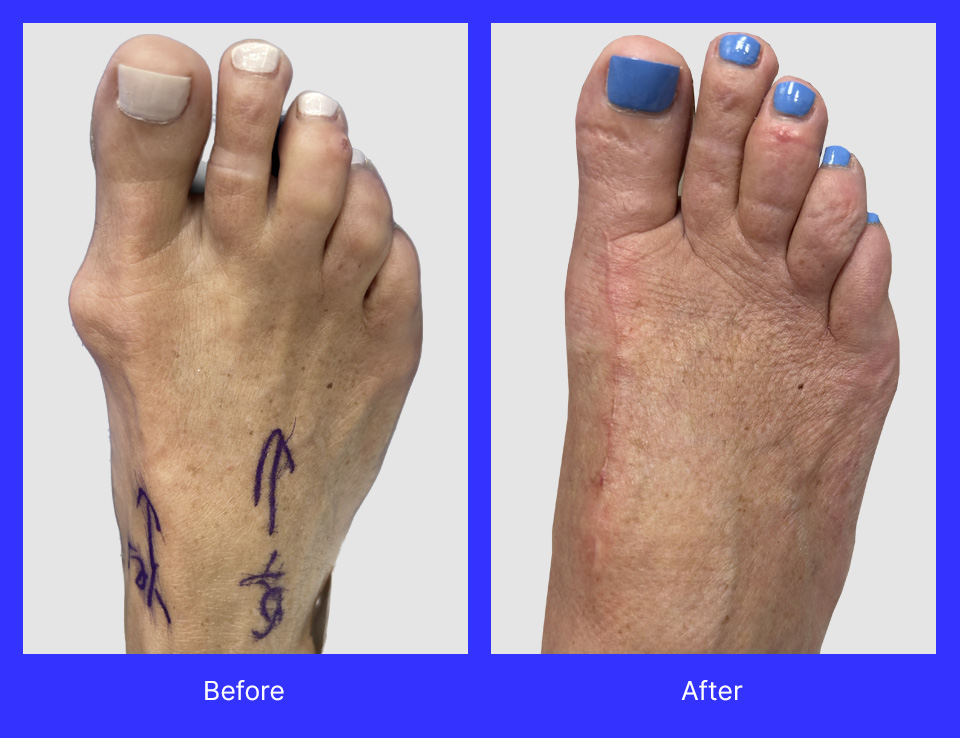
Surgical Techniques
Bunion surgery may be simple or complex and uses various techniques, from traditional open surgical procedures to more modern methods. Common surgical techniques include:
- Traditional Open Surgery: In open bunion surgery, an incision is made on the side of the big toe joint, to be followed by bone removal. This allows for direct visualization and manipulation of bones and soft tissues during the procedure.
- Minimally Invasive Surgery (MIS): With MIS techniques, either smaller incisions are made, or special instruments are used so that bunion deformity can be addressed. MIS approaches produce less soft-tissue trauma, have reduced postoperative discomfort, and patients recover more quickly than with traditional open surgery.
- Percutaneous Surgery: For a percutaneous bunion operation, small incisions are made under local anesthesia. Specialized tools help to do bone cuts and realign the joint without exposing the surgical site in. This approach is not done very often.
Outcomes and Complications of Bunion Surgery
Overall, the success rates for bunion surgery are quite high, as many patients experience marked improvement in foot function and pain after surgery. Studies show that bunion surgery has a success rate of 85%-90%. Personally, I find these numbers low compared to the amazing results we see in our office. Most people come away from the operation satisfied with its result. In short, success means pain relief, correcting foot alignment, and restoring normal foot function.
Factors that might affect the success of bunion surgery include how well patients follow postoperative care instructions, good rehabilitation, and how these or other contributing foot mechanics are dealt with to prevent recurrent bunions.
Although bunion surgery is, in general, safe, there are risks and potential complications that bode ill for just about every kind of operation. The following are examples of common complaints one might encounter after bunion surgery:
- Infection: After a bunionectomy has been performed, infection at the site is possible. Careful treatment of wounds plus timely use of antibiotics and sterile surgical techniques to prevent infection risk reduce the incidence of this complication.
- Nerve Damage: When surgery for bunions is carried out, there’s a risk that nerves near the area might be harmed, resulting in numbness or a tingling sensation in one’s foot. This kind of nerve injury is generally temporary, but some may need additional treatment or follow-up examination.
- Delayed Healing: After bunion surgery, some patients may experience delayed wound healing, or their bones fail to unify. Factors like smoking, diabetes, and poor blood circulation can heighten the risk of delayed healing.
- Recurrence: Although bunion recurrence following surgery is still relatively rare, it can happen. A revision may be required where there is a recurrent deformity.
How to Prevent Bunions?
It’s important to take preventive measures to avoid bunions, not only keeping your foot healthy but also seeking to identify them early and treat any curative factors that may develop into bumps later. In combination with preventive strategies, individuals can reduce their risk of having bunions and maintain comfortable and practical use for their feet. The items below are key preventive measures for bunions.
Choosing Proper Footwear
Selecting appropriate footwear is vital for preventing bunions and reducing the unpleasantness of foot deformities. Select shoes with a large toe box to provide plenty of space for toes to spread and help avoid overcrowding.
Choose shoes that have sole support and are low-heeled (3.0 cm or less) in order to keep the foot properly aligned. Avoid narrow, pointed, or high-heeled shoes: they could crowd your toes and contribute to bunion formation.
Look for shoes made of soft and breathable material that shapes itself to your foot and offers cushioning and support for each step you take. Frequent assessments of worn-out or badly fitting shoes can help prevent foot ailments, and necessary replacements will benefit your health.
Maintaining Healthy Foot Mechanics
Cultivating correct footing mechanics is essential for reducing bunion formation due to biomechanical imbalance. Consider the following tips to cultivate proper foot mechanics:
Most important is to have a custom molded orthotic made for your feet. Orthotics with good shoes is the only way to help reduce the pronatory forces on the first MPJ during walking.
Stand tall and control your posture and alignment so weight is distributed evenly across your feet: it puts less pressure on your toes and forefoot.
Exercise and stretch the muscles of your feet and lower limbs to build stability and support.
Disperse body weight evenly to avoid excessive force on the toes and forefoot during standing, walking, or other activities.
Pay close attention to the positioning and movements of your feet in everyday activities, and adjust your shoes or gait pattern as necessary to avoid placing unnecessary strain on your feet.
Conclusion
By integrating professional guidance and proactive foot health management, people can effectively control bunions and have comfortable, healthy feet in the long run.
Consultation with a podiatrist or orthopedic surgeon specializing in lower leg disorders is essential for accurate diagnosis and total bunion care. These doctors have special training and are familiar with a variety of foot conditions.
To sum up, bunions are cured by examining the feet for clinical features, imaging the feet nocturnally, and consulting a healthcare professional with the right qualifications. Early diagnosis and treatment are crucial to prevent bunion deformities and address any related defects effectively.
References
- Aebischer AS, Duff S. Bunions: A review of management. Aust J Gen Pract. 2020 Nov;49(11):720-723. doi: 10.31128/AJGP-07-20-5541. PMID: 33123707.
- Ferrari J. Bunions. BMJ Clin Evid. 2009 Mar 11;2009:1112. PMID: 19445756; PMCID: PMC2907787.
- InformedHealth.org [Internet]. Cologne, Germany: Institute for Quality and Efficiency in Health Care (IQWiG); 2006-. Bunions: Overview. 2018 Jun 28. Available from: https://www.ncbi.nlm.nih.gov/books/NBK513134/
- Kuhn J, Alvi F. Hallux Valgus. [Updated 2023 Aug 28]. In: StatPearls [Internet]. Treasure Island (FL): StatPearls Publishing; 2024 Jan-. Available from: https://www.ncbi.nlm.nih.gov/books/NBK553092
- Nork SE, Coughlin RR. How to examine a foot and what to do with a bunion. Prim Care. 1996 Jun;23(2):281-97. doi: 10.1016/s0095-4543(05)70276-1. PMID: 8784930.



